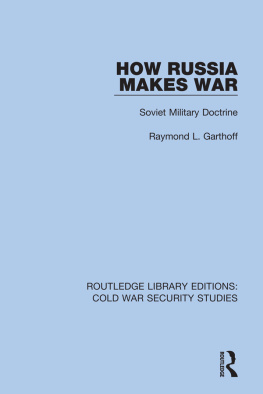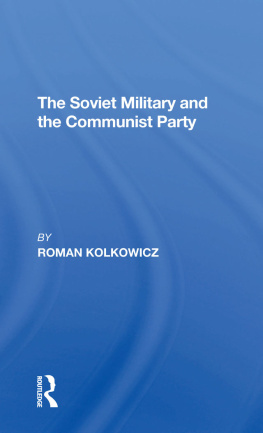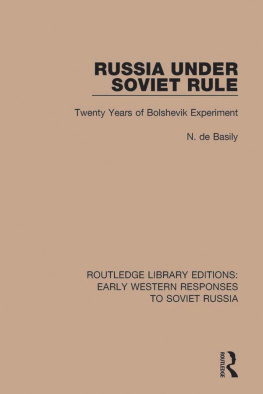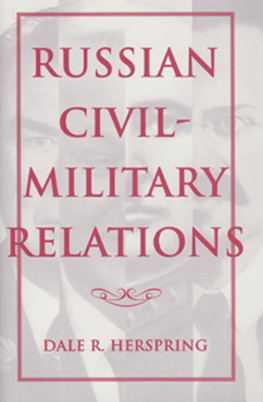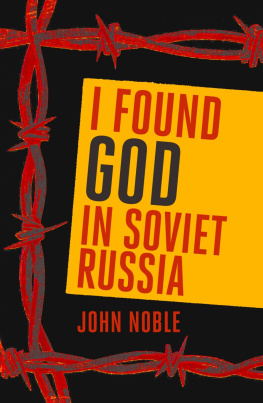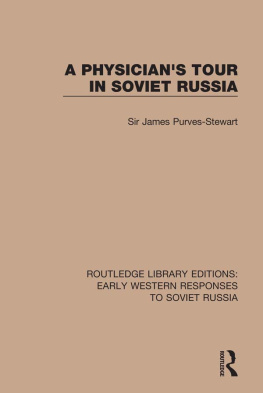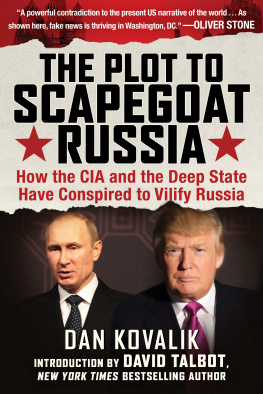Published in the USA under the title
SOVIET MILITARY DOCTRINE
by the Free Press, Glencoe
Copyright in the USA
First published in Great Britain in 1954
This book is copyright under the Berne Convention. Apart from any fair dealing for the purposes of private study, research, criticism or review, as permitted under the Copyright Act 1911, no portion may be reproduced by any process without written permission. Enquiry should be made to the publisher.
Printed in Great Britain by
Bradford and Dickens
London W.C.I.
D ESPITE unimpressive performances in earlier struggles, the Red Army emerged from World War II the largest and in some respects the most powerful ground force in the world. The politico-military influence exerted by this army not only assured the communist domination of the Axis satellite states, but, even in the face of a temporary American monopoly of atomic weapons, gravely threatened the security of western Europe. It remains the principal menace to world peace. Yet so little is known about this military force that one author writing on the Red Army appropriately entitled his book The Unknown Army. The number of really useful books on the Red Army appearing in the English language can be listed on the fingers of one hand. Until Mr. Garthoff supplied the deficiency, there was not a single one available on Soviet military doctrine.
Military doctrine may be said to consist in the guiding policies, basic assumptions, fundamental principles, and methods of achieving a nations political objectives by military means. Strategy and tactics, weapons systems, training and discipline all contributeunder the guiding influence of doctrineto the attainment of the objectives sought. If the doctrine is sound and well calculated to serve the national interest in a given situation, the attainment of objectives will be accomplished in economical fashion. If not, false doctrine may lead to national disaster. The usefulness of Mr. Garthoffs soundly documented pioneer study to anyone trying to understand the requirements of western European and American security can hardly be overestimated.
In preideological days the study of military doctrine was a simpler matter than it is today. Since Soviet military doctrine is bound up with revolutionary and party origins, with the day-to-day matters of political control of the USSR and its satellites, and with the inevitable problem of world conquest, it is, as the reader of this volume will soon discover, a complicated matter requiring frequent restatement in order to win full acceptance even among its own authors. Once accepted, however, doctrine takes on a special political sacredness which makes it hard to alter in any way.
It is precisely in the claim that its military doctrine is something unique and always correct that the Soviet Union lays itself open to the most dangerous errors in the future. It is also in this field that history presents the most embarrassing refutations of its theories. As in the case of Fiihrer worship with the Nazis, the glorification of Stalinor whoever may be the ruler of the Soviet Union in the futureis certain to present grave handicaps to the efficient functioning of the Red Army. This will be true simply because the military doctrine he has approved must always be right. The corrective force of experience has been and will be slow to make itself felt in the military operations conducted by the Soviet Union, even in the face of threatening disaster.
This accounts in part for the narrow margin by which the Soviet Union escaped military defeat in the summer of 1941. Soviet military doctrine had not changed substantially in the period from 1939 to 1941; yet Stalin, in an expansive mood at Teheran, admitted that the Red Army was poorly organized and inefficient during the Finnish war (19391940) and had to be reorganized. Despite this he said that the Red Army was unable to meet the Wehrmacht on equal terms in the summer of 1941. It had to be reorganized again in the midst of the German war before it became what Stalin called a genuinely good army. The Russian people and the troops of the Red Army were heroic; this Stalin admitted. Soviet military doctrine was correctit had to be. What, then, can explain the defeats and losses which almost destroyed the Soviet State in the summer of 1941? The answer may well be found in the frantic efforts made in the Soviet Union to glorify Stalin as a military leader and thus conceal his primary responsibility for the failures and losses of that year.
Military forces in action look and perform differently from the way they do in theory or on the parade ground. Thus, when Stendhals youthful hero in ha Chartreuse de Parme rushed toward Waterloo to see Napoleons famous army, he found only a rabble of thieves and cutthroats who promptly stole his horse. So it was with the Red Army in World War II. Despite all the precautions which the Soviets took to keep Allied observers away from the fighting front, a considerable number of Allied officers and large numbers of Germans saw the Red Army in action. What they saw did violence to many of the doctrines enshrined in Soviet military literature. As Lord Kitchener once said, One makes war as one mustnot as one would like to. The task of the student of military affairs is to determine how much of Soviet military doctrine is real and how much is political window dressing, or klyukva, a Russian word sometimes used to describe a certain type of amusingly inaccurate information.
Though change is slow, the rate at which it occurs in Soviet military doctrine is a matter of vital importance to all countries outside the iron curtain. If the Soviets maintain for a considerable period of time the doctrines described in this volume, the menace which the Red Army poses to the security of western Europe and the United States will remain at a certain degree of magnitude. If these doctrines should undergo radical change in the next decade, the danger might be of an entirely different character.


